2 青海师范大学, 高原科学与可持续发展研究院, 青海 西宁 810008;
3 西北师范大学地理与环境科学学院, 甘肃 兰州 730070)
史前人类对青藏高原极端环境的适应, 尤其是高原动物驯化及畜牧业的起源是学术界关注的焦点问题。青藏高原气候寒冷干燥且多变、辐射强, 是全球环境最为极端严酷的地区之一[1], 对这一极端气候环境下人类生存与适应的过程机制备受学术界广泛关注[2~4], 其适应主要体现在对生存空间选择和对动植物资源利用策略转变两个方面, 二者是相互联系的[5~6]。青海省东北部地区作为青藏高原主要的组成部分, 地貌类型多样, 史前文化遗存丰富且序列完整[7], 是研究史前人类生理适应和行为适应的理想区域[8]。随着考古资料的积累和研究的深入, 近年来该区域的农作物遗存研究取得了重要进展[9~19]。而动物资源作为原始居民生活中必不可少的食物资源, 在当时的生业模式中同样充当着重要角色。但从现有动物考古遗存研究的时空分布来看, 本区域已开展系统的动物遗存研究多集中在新石器至铜石并用阶段的黄河上游谷地[20]、群尖盆地[21]、大通河流域[22~23]及湟水谷地[24]等河谷区域, 极少涉及到青铜时代以高海拔草原生态环境为背景的地貌单元进行系统动物考古学的研究。这无疑在很大程度上限制了人们对青铜时代草原环境中动物资源利用情况的科学认知。而本研究区(青海湖盆地)作为河湟谷地农业区向青南高原牧业区的过渡地带, 呈明显草原地带特征。因此, 本文通过对青海湖盆地尖嘴遗址发掘出土的动物遗存材料进行整理分析, 并结合青海省东北部地区已有的动物遗存研究, 探讨了中晚全新世以来本区先民动物资源的获取利用方式及当时的家畜饲养状态, 揭示了高原东北部地区先民对动物资源利用与开发的演变规律, 并为本区动物遗存研究提供补充材料, 同时亦对深入认识与理解史前人类适应青藏高原高寒缺氧环境的过程机制具有重要科学意义。
1 研究区域青海湖盆地(36°15′~38°20′N, 97°50′~101°20′E; 海拔3100~4755 m), 位于青藏高原东北部, 处于东亚夏季风、印度季风与西风交互作用区[25]。其大致范围包括大通山以南、日月山以西、橡皮山以东及青海南山以北的广大滨湖地区(图 1), 总面积约达29661 km2。该盆地属于高原大陆性气候、高寒半干旱区, 光照充足、日照强烈、冬寒夏凉、冷季漫长、暖季短暂[26]; 年平均气温-0.3 ℃, 年均降水量360 mm, 降水多集中在5~9月份, 雨热同期, 干湿季分明[27]。因受其地理位置、地貌类型、气候特征及海拔高度等多种因素影响, 青海湖盆地生境类型复杂多样, 发育多种植被类型, 主要有高寒灌丛、寒温性针叶林、温带草原、高寒草甸、沼泽草甸和沙生植被等[28]; 动物资源中脊椎动物466种, 其中鱼类55种、鸟类292种、两栖类16种、兽类103种和哺乳类41种, 常见动物种属有黄羊(Procapra przewalskii)、藏原羚(Procapra picticaudata)、野牦牛(Poephagus grunnieus)、藏野驴(Equuskiang)、白唇鹿(Cervus albirostris)、马鹿(Cervus elaphus)、雪豹(Felis uncia)、猞猁(Lynx)、狼(Canis lupus)、喜马拉雅旱獭(Marmota himalayana)、鼠兔(Ochotona sp.)、盘羊(Ovisammon)、斑头雁(Anser ichthyaetus)、棕头鸥(Larus brunnicephalus)及青海湖裸鲤(Gymnocypris przewalskii)等[29]。
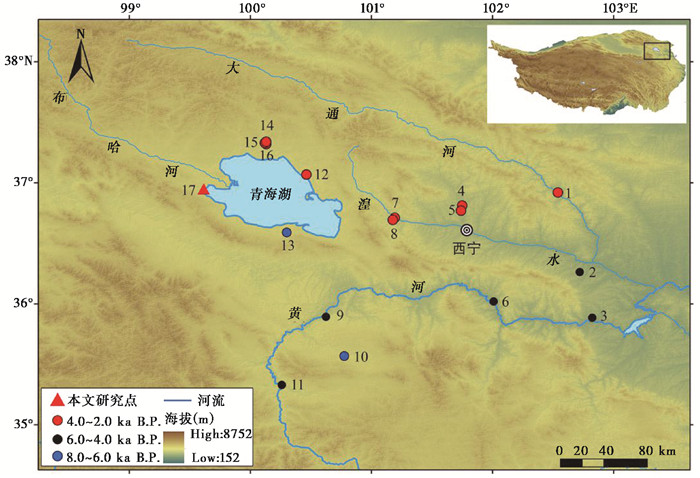
|
图 1 研究区位置图及本研究涉及遗址分布 1——金蝉口遗址(Jingchankou site); 2——核桃庄遗址(Hetaozhuang site); 3——胡李家遗址(Hulijia site); 4——长宁遗址(Changning site); 5——上孙家寨遗址(Shangsunjiazhai site); 6——安达其哈遗址(Andaqiha site); 7——大华中庄遗址(Dahuazhongzhuang site); 8——莫布拉遗址(Mobula site); 9——尕马台遗址(Gamatai site); 10——拉乙亥遗址(Layihai site); 11——宗日遗址(Zongri site); 12——上草褡裢湖遗址(Shangcaodalianhu site); 13——江西沟2号遗址(Jiangxigou 2 site); 14——扎卡拉瓦遗址(Zhakalawa site); 15——爱情崖遗址(Aiqingya site); 16——沙柳河桥西遗址(Shaliuheqiaoxi site); 17——尖嘴遗址(Jianzui site) Fig. 1 Location map of the study area and related site distribution |
我们于2017年6月在青海湖盆地野外调查时发现尖嘴遗址(36.95°N, 99.61°E; 海拔3350 m), 并在地表选取1 m×1.5 m的样方, 进行了小面积试掘。在深约为130 cm的剖面(图 2)中发现较丰富的动物碎骨(图 3a)、炭屑(图 3b)、石器(图 3c)及陶片(图 3d)等文化遗物。根据其结构特征可将其大致分为4层:
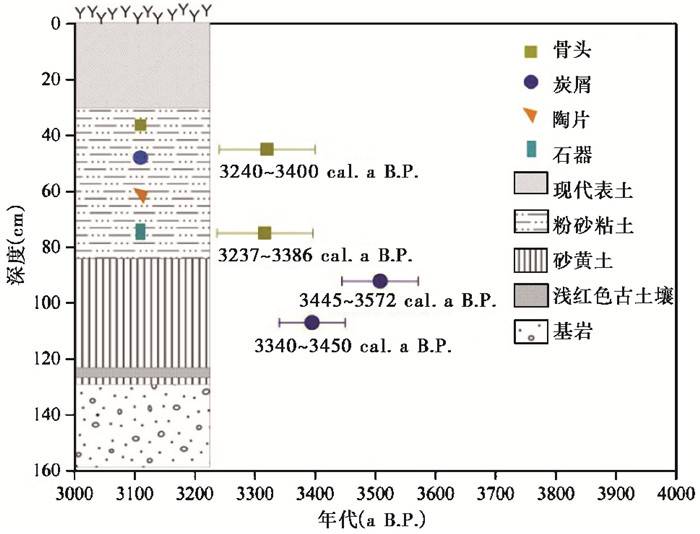
|
图 2 尖嘴遗址剖面图 Fig. 2 Jianzui site profile |
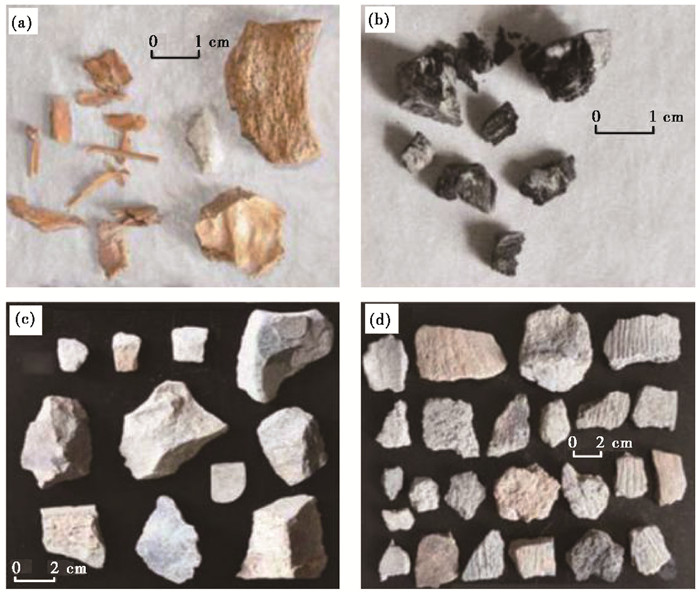
|
图 3 尖嘴遗址出土文化遗物 (a)48 cm处采集的动物碎骨(animal bones collected at 48 cm); (b)66 cm处采集的炭屑(charcoal collected at 66 cm); (c)30~85 cm采集的打制石器(chip stones collected at 30~85 cm); (d)20~35 cm采集的夹砂绳纹粗陶(corded coarse pottery with sand collected at 20~35 cm) Fig. 3 Cultural relics identified from Jianzui site |
第1层(0~30 cm), 为现代表土层, 发育有现代高寒草甸土壤;
第2层(30~85 cm), 为灰黑色粉砂质粘土层, 该层中夹杂着大量炭屑, 出土有陶片、兽骨、石器等文化遗物, 其中骨头多为被敲碎的碎块, 部分疑似为骨器; 陶器与骨头(部分)有明显的火烧痕迹, 石器为打制石器, 技术较为粗糙, 其岩性与就近的出露基岩一致, 说明为就地取材;
第3层(85~130 cm), 为砂黄土, 土质较为疏松, 其底部发育一薄层(约2~3 cm厚)的浅红色古土壤, 属原生沉积地层, 人类活动干扰小;
第4层(130 cm以下), 为基岩, 未见文化遗物。
在挖掘尖嘴遗址时, 按剖面层位收集了出土的全部骨骼, 其过程如下:首先对出土骨骼进行清洗和编号, 登记动物骨骼378件; 其次对已收集动物骨骼进行鉴定, 鉴定内容包括部位、种属、左右侧、骨骼愈合状况、大小(样本占所属部位的体积及长度比例, 通常用 < 1/4, 1/4~1/2, 1/2~3/4, ﹥ 1/2~3/4)、风化级别、表面痕迹(切割或火烧)的测量值及重量等; 然后将全部骨骼归置各自出土层位, 按照文化层统计可鉴定标本数(NISP), 最后将所有获取数据和信息输入电子表格, 建立数据库。
本研究在整理鉴定时, 参照的标本主要来自中国社科院考古研究所科技考古中心动物考古实验室和中国科学院古脊椎动物与古人类研究所的现生和古代动物标本, 参阅《中国脊椎动物化石手册》[30], 《动物骨骼图谱》[31]等骨骼图谱。
2.2 AMS 14C测年在考古调查中, 我们首先基于遗址单位里的包裹物进行考古年代判定。在动物骨骼、炭屑等文化遗物鉴定和采集完毕后, 分别从剖面地层的45 cm、75 cm、75 cm和87 cm这4处层位依次选取了骨头、炭屑、骨头和炭屑4个测年样品(分别是A45B、A75C、A75B和A87C, 见表 1), 送至美国Beta实验室进行加速器质谱(Accelerator mass spectrometry)AMS 14C年代测定, 获得的14C年代应用Calib REV 7.0.2年代校正软件中的IntCal 13树轮校正曲线将其校正为日历年[32~33]。
| 表 1 青海湖盆地卡约文化遗址AMS 14C年代测年结果 Table 1 14C dating results on Kayue archaeological sites in Qinghai Lake Basin |
采用AMS 14C测年方法对青海湖盆地的尖嘴遗址剖面出土的骨头、炭屑进行测年。如表 1所示, 结果分别为3120±30 a B.P.、3270±30 a B.P.、3110±30 a B.P.和3160±30 a B.P., 经IntCal 13树轮曲线校正为日历年代, 校正后年代分别为3320±80 cal.a B.P.、3508±63 cal.a B.P.、3311±75 cal.a B.P.和3395±55 cal.a B.P.。考虑到炭屑测得年代普遍偏老, 故本文认为该遗址年代应为3.2 ka B.P.前后, 对应考古学的卡约文化时期(3.6~2.6 ka B.P.)[7]早期阶段。
另外, 通过野外观察:尖嘴剖面文化层中的陶片为夹砂粗陶, 多数陶片表面饰有绳纹和划纹, 属于典型的卡约文化陶器(图 3d); 并在地层中发现炭屑、石器等人类活动遗迹, 这些材料都充分说明了该地层为卡约文化时期受人类活动影响明显的沉积地层, 这与AMS 14C测年结果相一致。
3.2 动物骨骼种属鉴定结果在尖嘴遗址中, 共采集378块动物骨骼, 包括完整骨骼207块, 碎块(有残缺)骨骼171块。详细结果(残/碎块不计)如下:
原羚属(藏原羚):发现完整左角1块、右肱骨远端2块、左肱骨近端1块、右根骨远端1块、左根骨远端1块、左肱骨远端1块, 共7块。
羚羊亚科:发现左桡骨近端2块、左跟骨1块、右盆骨髋臼1块、左胫骨近端2块、右桡骨骨干1块、左桡骨/尺骨1块、左尺骨骨干1块、左股骨骨干1块、盆骨髂骨/髋臼1块、第一趾骨远端4块、左中央腕骨1块、右胫骨骨干3块、右跖骨骨干1块、左游离牙齿1颗、左盆骨髂骨/髋臼2块、右跖骨近端1块、右胫骨远端1块、右跖骨远端1块、左掌骨远端1块、左髌骨1块、右游离牙齿2颗、第二趾骨(有食肉咬痕迹)1块、右股骨远端1块、桡骨骨干2块、左胫骨远端1块、右上颌骨1块、右肩胛骨近端1块、左下颌骨1块、寰椎1块、枢椎近端1块, 左肱骨远端1块、右桡骨近端2块、掌骨骨干1块、左掌骨近端1块、右肩胛骨(碎块)1块, 共45块。
羊亚科:仅发现右跟骨1块。
羊/羚羊亚科:发现左头骨顶骨1块、掌/跖骨远端1块、左股骨远端1块、右股骨近端1块、第一趾骨远端1块、右游离牙齿1颗、游离牙齿(碎块)1块、左游离牙齿1块、右肩胛骨1块, 共8块。
鹿:发现左下颌骨1块、盆骨髂骨1块、胫骨骨干1块、右桡骨近端1块、右尺骨近端1块、右胫骨近端1块、右盆骨髂骨2块、左胫骨远端2块、股骨骨干1块、肩胛骨近端1块、下颌骨1块、右下颌骨1块、籽骨1块、鹿角(残片)2块、左盆骨髂骨1块, 共16块。
鲤科鱼类:发现左舌颌骨3块、翼骨2块、脊椎椎体10块、右鳃盖骨8块、棘刺1块、腮盖条2块、左鳃盖骨2块、左咽齿2块、左角舌骨1块、左方骨2块、基鳍骨2块、尾舌骨1块、头骨(碎块)1块、右上颌骨1块、左匙骨3块、基枕骨8块、碎块32块、右舌颌骨3块、左齿骨2块、右齿骨3块、顶骨2块、隅骨1块, 共59块。
中哺乳:发现长骨(碎块)114块、肋骨26块、脊椎(碎块)2块、长骨28块(其中3件有烧黑痕迹)、脊椎椎体3块、肋骨4块、桡骨骨干1块、左股骨1块, 共63块。
大哺乳:发现肋骨(碎块)5块、脊椎(碎块)2块、头骨(碎块)2块、长骨(碎块)9块(其中1块疑似骨铲、1块有烧黑痕迹)、肋骨4块, 共4块。
豹:发现左肱骨远端1块、左肩胛骨近端1块, 共2块。
狗:仅发现左桡骨远端1块。
鸟:仅发现下颌骨1块。
按照统计可鉴定标本数(NISP)的基本方法, 尖嘴遗址文化层里各类动物的可鉴定标本数(表 2)及其在全部动物中所占的比例(图 4)分别为:原羚属7块, 占比3.38 %; 羚羊亚科45块, 占比21.74 %; 羊亚科1块, 占比0.48 %; 羊/羚羊亚科8块, 占比3.86 %; 鹿16块, 占比7.73 %; 鲤科鱼类59块, 占比28.50 %; 中哺乳63块, 占比30.43 %; 大哺乳4块, 占比1.93 %; 豹2块, 占比0.97 %; 狗1块, 占比0.48 %; 鸟1块, 占比0.48 %。总结得出, 中哺乳动物最多, 其次为鲤科鱼类。
| 表 2 尖嘴遗址动物遗存的可鉴定标本数(NISP) Table 2 The number of identified specimens of animal remains in Jianzui site |
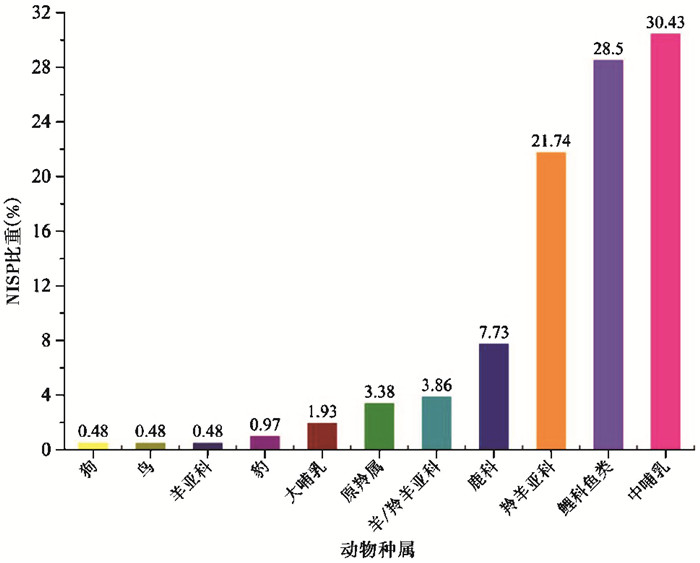
|
图 4 尖嘴遗址动物骨骼可鉴定标本数(NISP)比重 Fig. 4 Percentage of NISP of animal bones at Jianzui site |
已有研究表明, 史前人类早在晚更新世末期至全新世早中期阶段已扩散至青藏高原东北部地区, 并以采用石片及少量细石叶技术[34], 进行季节性狩猎采集活动[3~4]。本文为了便于讨论, 现将中全新世划分为早期阶段(8.0~6.0 ka B.P.)和晚期阶段(6.0~4.0 ka B.P.)。
8.0 ~6.0 ka B.P., 研究区有动物遗存报道的遗址仅包括青海湖盆地的江西沟2号[35]和共和盆地的拉乙亥[36]遗址。其中, 前者所发现的动物群包括羊(Ovis sp.)、羚羊(Gazella sp.)、鹿(Cervidae)、小型哺乳(Mammalia)和啮齿类动物(Rodentia); 后者发现的动物群有环颈雉(Phasianus colchicus)、鼠兔(Ochotona sp.)、沙鼠(Meriones sp.)、喜马拉雅旱獭(Marmota himalayana)、狐(Vulpes)、羊(Ovis sp.)及破碎鸟蛋壳。从上述的动物种属看, 两处遗址中均以野生动物资源占据绝对地位, 狩猎对象以羊、鹿、鼠兔及旱獭等中小型野生动物为主, 狩猎经济是此阶段主导性生业模式。当然, 也不能排除当时存在家畜饲养的可能, 最新基因组测序研究[37]表明, 牦牛于7.3 ka B.P.左右在青藏高原已被原始居民驯化。狗作为原始居民最早被驯化的家养动物[38], 在遗存中并未发现, 但也不能排除先民未将狗驯养, 其最初目的可能是为了提高狩猎效率而非肉食[39~40]。与此同时, 先民可能认识到狗的驯化在一定程度上提高了狩猎效率, 便选择性保留了狗的这一功用[41], 以至于狗在随后的各个时期均有沿用。江西沟2号遗址和拉乙亥遗址中的羊/羚羊, 很可能均为野生种属, 此阶段并未被驯化[42~44]传入至青海省东北部及邻近地区。其中部分动物标本出现的砸击、刻划及火烧痕迹, 明显是先民加工食物的行为所致。这种完全依赖于狩猎居住地周边自然环境中的野生动物来获取肉食供给的方式被称为“依赖型”[45]。
6.0 ~4.0 ka B.P., 以共和盆地的宗日遗址(5.4~4.0 ka B.P.)[46]和群尖盆地的安达其哈遗址(5.0~4.8 ka B.P.)[12]为代表。宗日遗址动物鉴定结果显示(图 5a)[20], 野生动物种属包括鹿科动物、羊亚科、羚羊亚科、牛科、啮齿类旱獭、野生肉食类、鸟类等, 所占比依次分别为27.00 %、44.00 %、9.00 %、1.00 %、12.00 %、3.00 %和2.00 %, 其总占比约达98.64 %, 而家养动物狗仅为1.36 %。上述动物遗存数据显示, 先民消耗的动物资源中野生动物占据绝对优势地位, 且所利用的动物品种复杂多样, 羊亚科、鹿科、啮齿类等大中小型动物均在居民利用范围内。其中, 鹿科、牛科及羊亚科等出现可能与毛皮的广泛使用有关, 因其毛皮可用于制衣, 遗址中大量骨制生活用具(锥和针)的发现[47], 就是最好的例证, 显示宗日文化先民对动物产品的利用程度较高。Wang[21]对安达其哈遗址的鉴定结果显示(图 5b), 动物种属包含鹿科、羊亚科、羚羊/原羚属、牛科、猪、食肉目(狗)、兔形目、啮齿目及鸟类等, 所占比依次分别为50.80 %、23.20 %、4.20 %、8.20 %、2.90 %、4.90 %、1.30 %、1.80 %及2.70 %。由此可见, 该遗址先民的肉食来源中, 野生动物占当时食谱中最主要的部分, 家养动物(猪和狗)在先民消费的肉食资源中比例偏少。暗示先民当时的家畜饲养水平能力有限, 对于家养动物的驯养仅可能是尝试性的, 先民仍凭借消耗人力物力较少却能得到较大回报的肉食资源获取方式(狩猎)来获得稳定的肉食资源, 而家畜饲养只是作为肉食资源的额外补充。另外, 仰韶文化晚期的青海民和胡李家遗址(5.5~5.3 ka B.P.)[12]中, 发现了野生动物鹿、犬科动物、啮齿动物、鸟类及家畜动物(羊、猪、狗)的遗骸[48]; 马家窑文化时期的民和核桃庄遗址[49]和贵南尕马台遗址[50]中, 也发现了饲养家畜猪、狗、羊的遗存, 可见这种情况是当地长期的传统。综上证据表明, 此阶段研究区先民主要猎取野生动物(鹿科、羊亚科)来获取稳定的肉食资源, 同时适当性饲养一定量的家养动物(猪、狗), 作为另外一种获取肉食资源的辅助手段。这种依靠遗址区周围自然环境中的野生动物资源, 家养动物仅作为肉食资源补充的方式, 说明该时期处于“初级开发型”阶段[45]。
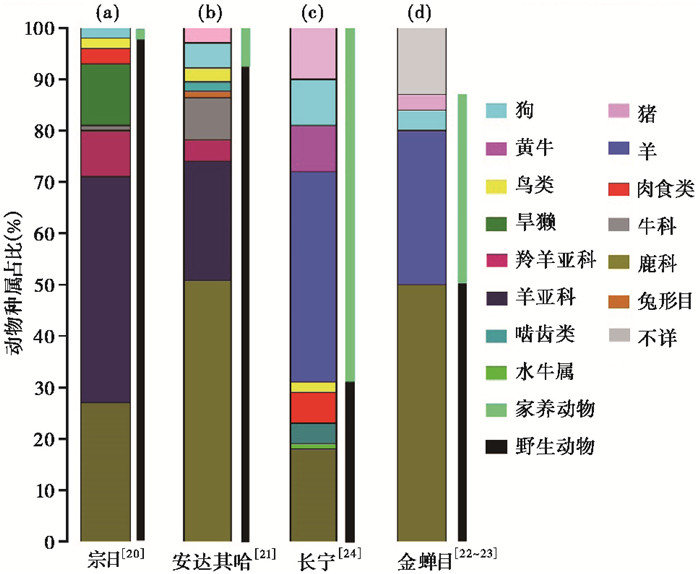
|
图 5 青海省东北部地区的动物资源利用 Fig. 5 Utilization of animal resources in the northeast Qinghai Province |
晚全新世(4.0~2.0 ka B.P.), 随着东西方文化交流的加强, 起源于西亚的麦类作物和家养牲畜(牛羊等)传播至本区[51~52], 并开始稳定嵌入原来的本土生业经济系统[53], 促使本区生业模式产生了重要技术革命性的变化[54]。该阶段典型动物遗存包括长宁遗址(4.1~3.6 ka B.P.)[24]、金蝉口遗址(3.9~3.8 ka B.P.)[17]及本文所述的尖嘴遗址(3.2 ka B.P.左右)。
尖嘴遗址可鉴定标本数(NISP)分析结果(图 4)显示, 中哺乳动物占30.43 %, 鲤科鱼类青海湖裸鲤(Gymnocypris przewalskii)占28.50 %、大哺乳占1.93 %、羊(Ovis sp.)/羚羊亚科(Antilopinae)占3.86 %、原羚属(Saiga tatarica)占3.38 %、鹿(Cervidae)占7.73 %、豹(Panthera sp.)占0.97 %、羊亚科(Caprinae)、狗(Canis familaris)、鸟(Aves)均占0.48 %。尖嘴卡约文化先民捕食的对象以野生中哺乳动物为主, 其次为渔猎, 而狗是唯一确认的家养动物, 属低水平食物生产的“初级开发型”模式, 但这也并不足以代表其生业经济中没有其他家畜动物的饲养或是畜牧成分的存在。需要指出的是, 中哺乳动物比重将近达到三成(30.43 %), 推测除先民作为肉食资源的补充(部分有烧黑痕迹)外, 还可能与先民的行为意识有关。考虑到现今青海湖流域仍有中哺乳动物中的狼(Canis lupus)和猞猁(Lynx)等害兽活动[29], 且偶尔会袭击家畜和人群[55], 先民可能为了保护家畜(种群)或处于自身安全的考虑, 将其视为威胁进行猎杀。而猞猁的皮毛适合御寒[56], 说明先民可能有意识地捕杀这种猫科动物以获得它们的毛皮。3.5~2.5 ka B.P.左右青海湖水位和盐度的降低[57~59], 使得位于青海湖流域最大河流(布哈河)成为青海湖裸鲤(Gymnocypris przewalskii)每年月(集中在5~9月)洄游产卵的主要场所[60], 而这为尖嘴卡约文化先民提供了较好的食物来源, 便于该地区先民从事渔业活动, 即利用周围丰富的淡水资源获取肉食; 但考虑到鱼类资源对先民所提供的肉食贡献量较低, 表明在当时先民的生业模式中仅处于辅助地位。而少量的家养动物(狗)则扮演助手角色, 帮助先民进行狩猎活动。以狗而言, 对其的驯养能够提高先民的狩猎效率, 譬如可用于追踪、追捕及看守猎物等[61], 尖嘴卡约遗址中大量野生动物的发现, 应该与狗的驯养有直接关系。此外, 大量考古发掘资料显示, 卡约文化墓葬中普遍出现随葬动物(羊、牛、马、狗等)[17, 62], 如大通县上孙家寨[63]、湟源县大华中庄、塔尔湾及申中乡等墓葬中发现殉葬的马、牛、羊的骨骼[64~65]; 湟源县莫布拉遗址中, 发现以牛羊粪作为燃料的情况[66]。上述证据与我们的认识较相符(即卡约时期尖嘴先民的经济生活中可能存在一定比例的畜牧成分)。植物考古研究显示[9~10], 卡约文化先民种植作物以大麦为主、粟黍和小麦为辅。然而生产工具分析却表明, 青海中东部的卡约遗址中发现的细石器或与牧业有关的骨质(骨锥、骨铲、骨簇、骨管)、石质和铜质工具等较多[67], 用于作物生产的工具(石刀等)较少[68]; 另外, 卡约文化器物上常见有羊、牛、犬、鹰和鸟等动物纹饰[69]。这些证据同样表明狩猎和放牧活动较农业生产活动在其先民生活中的地位更为重要。除此之外, 同处于青海湖盆地的上草褡裢湖、沙柳河桥西、爱情崖及扎卡拉瓦等卡约文化遗址中, 也鉴定出羊、牛和大量鱼骨骼[12], 进一步说明卡约文化牧猎生产力的发展水平, 足已构成卡约文化的经济主体, 而渔猎可能是辅助生业模式。总之, 狩猎业在卡约文化尖嘴遗址中呈现的重要性是不言而喻的, 代表了一种高原特殊(草原)环境中的史前生业模式。
长宁遗址动物鉴定结果(图 5c)显示[24], 野生动物群由鹿科、水牛属、啮齿类、肉食类及鸟类等组成, 所占比分别为18.00 %、小于1.00 %、4.00 %、6.00 %及2.00 %, 约占动物群总数的30.00 %; 家养动物则由羊、黄牛、家猪及狗等种属构成, 所占比依次为41.00 %、9.00 %、11.00 %及9.00 %, 约占动物群总数的70.00 %。可见长宁先民利用的家养动物占据主导并较为多样, 包括从事猪、狗、牛、羊在内的多种类的家畜饲养方式, 野生动物种属亦较为广泛但利用率较低。植物资源利用方面, 在湟水谷地的东村(甲)(4773±193 cal.a B.P.)[12]、喇嘛刺坡[12]、阿家村(3975±107 cal.a B.P.)[17]和杨家寨坡(4064±83 cal.a B.P.)[17]等齐家文化遗存中均有数量可观的粟黍农作物出现, 说明稳定的农业活动是齐家先民重要生产方式, 而这为家畜饲养提供了物质保障。另外, 长宁遗址中还出现了少量用于狩猎活动的石球、细石器及骨簇等工具, 表明狩猎活动是长宁先民的辅助生计方式[70]。这种以依靠饲养家养动物供给肉食资源, 同时在一定程度上狩猎居住地周围自然环境中的野生动物获取肉食资源的模式, 属于“开发型”[45]。金蝉口遗址动物鉴定结果(图 5d)显示[22~23], 野生动物中仅鹿科动物(马鹿、梅花鹿、狍子、獐、麝等)占动物群的50.00 %多; 家养动物中的羊(绵羊/山羊)占动物群的30.00 %左右, 狗在动物群中所占比例为4.00 %, 猪数量极少(推测与狗的数量相当或更少)。从上述动物遗存数据可发现, 金蝉口先民获取肉食资源的主要途径是从事狩猎活动, 其主要猎取对象则为大中型鹿科动物。此外, 家养动物门类多样, 除羊之外, 还饲养一定比例的狗和猪, 但上述家养动物数量较为悬殊, 如家畜羊(30.00 %)明显占据优势地位, 而狗(4.00 %)和猪(≤4.00 %)数量则明显偏少。总之, 金蝉口先民猎取鹿科为主的野生动物来保证肉食资源供应, 且从事一定规模的家畜饲养活动。炭化植物浮选结果显示[15], 金蝉口遗址粟、黍、大麦及小麦分别占农作物遗存的69.40 %、27.80 %、2.70 %和1.00 %, 说明金蝉口居民主要从事以粟黍为主的旱作农业, 小规模麦类作物为辅的农业生产方式。但生产工具统计表明[70], 该遗址中与狩猎活动有关的石球、石簇及细石器居多(约占工具总数的93.00 %), 说明该遗址存在更多的狩猎成分。除生产工具外, 这也在人骨同位素研究[71]中得到了验证, 金蝉口居民的δ 15 N值(8.88±0.05 ‰)均高于野生鹿科(3.09±0.75 ‰)和野生羊亚科(2.03±0.69 ‰), 进一步说明本遗址先民摄食了大量的野生动物资源, 与遗址中野生动物比重较大相吻合。如上所述, 此阶段的生业属于“低水平的食物生产”阶段[72], 获取肉食资源的模式处于“初级开发型”阶段。
综上所述, 中西方史前文化交流(家畜牛、羊的传入)为青海省东北部地区先民生业模式的转型及畜牧业的发展提供了先决条件[68, 73]。晚全新世研究区已存在较为成熟的家畜饲养业, 不同自然环境背景差异导致动物资源的获取利用方式截然不同, 表现在青海湖流域的尖嘴遗址形成渔猎为主、兼营牧业的生业系统; 湟水谷地的长宁遗址形成以种植业和畜养业为主、狩猎业为辅的经济系统; 大通河流域的金蝉口遗址则形成以狩猎业为主, 种植业、畜养业为辅的经济格局。
5 结论本文对青海湖盆地卡约文化尖嘴遗址的动物遗存进行研究, 并结合已有研究成果, 探讨了全新世中期至晚期(8.0~2.0 ka B.P.)青海省东北部地区先民对动物资源获取利用的方式及家畜饲养状态。结论如下:
(1) 中全新世的早期阶段(8.0~6.0 ka B.P.)青海省东北部地区为纯粹的狩猎经济为主, 呈现出典型的“依赖型”生业模式特征。
(2) 中全新世的晚期阶段(6.0~4.0 ka B.P.)先民利用的动物资源主要来自于野生动物, 家养动物所占比重较小, 仅有猪和狗。此阶段先民获取动物资源方式以狩猎经济为主, 家畜饲养业已经产生且处于初始阶段, 生业属于“低水平的食物生产”阶段, 获取肉食资源的模式处于“初级开发型”阶段。
(3) 晚全新世阶段(4.0~2.0 ka B.P.), 相比于前两者, 本阶段青海省东北部地区先民利用动物资源方式呈现多样化, 构成了依赖野生动物(鹿科、羊/羚羊亚科)为主的“初级开发型”及主要依靠家畜饲养(牛羊为主, 猪狗为辅)的“开发型”两种。
(4) 4.0 ka B.P., 史前欧亚大陆文化交流背景下, 西方驯化家畜(牛、羊)的引入及不同海拔自然环境背景差异是导致青海省东北部地区先民获取肉食资源方式发生历时性变化的决定性因素。
致谢: 匿名审稿专家和编辑部杨美芳老师宝贵的修改意见; 兰州大学历史文化学院任乐乐老师对动物骨骼的鉴定, 在此一并感谢!
| [1] |
侯光良, 许长军, 曹广超, 等. 青藏高原末次冰消期-全新世中期人类扩张的时空模拟[J]. 第四纪研究, 2017, 37(4): 709-720. Hou Guangliang, Xu Changjun, Cao Guangchao, et al. The spatial-temporal simulation of mankind's expansion on the Tibetan Plateau during Last Deglaciation-Middle Holocene[J]. Quaternary Sciences, 2017, 37(4): 709-720. |
| [2] |
Madsen D B, Ma H Z, Brantingham P J, et al. The late upper Paleolithic occupation of the northern Tibetan Plateau margin[J]. Journal of Archaeological Science, 2006, 33(10): 1433-1444. |
| [3] |
Brantingham P J, Gao X. Peopling of the northern Tibetan Plateau[J]. World Archaeology, 2006, 38(3): 387-414. |
| [4] |
高星, 周振宇, 关莹. 青藏高原边缘地区晚更新世人类遗存与生存模式[J]. 第四纪研究, 2008, 28(6): 970-977. Gao Xing, Zhou Zhenyu, Guan Ying. Human cultural remains and adaptation strategies in the Tibetan Plateau margin region in the Late Pleistocene[J]. Quaternary Sciences, 2008, 28(6): 970-977. |
| [5] |
陈胜前. 中国北方晚更新世人类的适应变迁与辐射[J]. 第四纪研究, 2006, 26(4): 522-533. Chen Shengqian. Enironment adaptation and diffusion of North China humans in Late Pleistocene[J]. Quaternary Sciences, 2006, 26(4): 522-533. |
| [6] |
Wang L, Yang Y, Jia X. Hydrogeomorphic settings of late Paleolithic and early-mid Neolithic sites in relation to subsistence variation in Gansu and Qinghai provinces, Northwest China[J]. Quaternary International, 2016, 426: 18-25. |
| [7] |
谢端琚. 甘青地区史前考古[M]. 北京: 文物出版社, 2002: 7-167. Xie Duanju. Prehistorical Archaeology of Gansu and Qinghai Province[M]. Beijing: Cultural Relics Publishing House, 2002: 7-167. |
| [8] |
Yi X, Liang Y, Huerta-Sanchez E, et al. Sequencing of 50 human exomes reveals adaptation to high altitude[J]. Science, 2010, 329(5987): 75-78. |
| [9] |
赵志军. 青海互助丰台卡约文化遗址浮选结果分析报告[J]. 考古与文物, 2004(2): 85-91. Zhao Zhijun. The analysis report about flotation results of Kayue culture site at Fengtai Qinghai Province[J]. Archaeology and Cultural Relic, 2004(2): 85-91. |
| [10] |
李明启, 葛全胜, 王强, 等. 青海卡约文化丰台遗址灰坑古代淀粉粒揭示的植物利用情况[J]. 第四纪研究, 2010, 30(2): 372-376. Li Mingqi, Ge Quansheng, Wang Qiang, et al. Ancient starch grains from ash pits of Fengtai site, Qinghai Province and their application in archaeology[J]. Quaternary Sciences, 2010, 30(2): 372-376. |
| [11] |
张小虎. 青海官亭盆地植物考古调查收获及相关问题[J]. 考古与文物, 2012(3): 26-33. Zhang Xiaohu. The result and its related issues of the investigation of archaeo-botanical remains in the Guanting Basin, Qinghai[J]. Archaeology and Cultural Relics, 2012(3): 26-33. |
| [12] |
贾鑫.青海省东北部地区新石器-青铜时代文化演化过程与植物遗存研究[D].兰州: 兰州大学博士学位论文, 2012: 31-133. Jia Xin. Cultural Evolution Process and Plant Remains during Neolithic-Bronze Age in Northeast Qinghai Province[D]. Lanzhou: The Doctoral's Dissertation of Lanzhou University, 2012: 31-133. |
| [13] |
张晨.青海民和喇家遗址浮选植物遗存分析[D].西安: 西北大学硕士学位论文, 2013: 1-34. Zhang Chen. Analysis of Flotation Plant Remains at Minhe Lajia Site in Qinghai Province[D]. Xi'an: The Master's Thesis of Northwest University, 2013: 1-34. |
| [14] |
Li M Q, Yang X Y, Ge Q S, et al. Starch grains analysis of stone knives from Changning site, Qinghai Province, Northwest China[J]. Journal of Archaeological Science, 2013, 40(4): 1667-1672. |
| [15] |
杨颖.河湟地区金蝉口和李家坪齐家文化遗址植物大遗存分析[D].兰州: 兰州大学硕士学位论文, 2014: 1-53. Yang Ying. The Analysis of Charred Plant Seeds at Jinchankou Site and Lijiaping Site during Qijia Culture Period in the Hehuang Region, China[D]. Lanzhou: The Master's Thesis of Lanzhou University, 2014: 1-53. |
| [16] |
D'Alpoim Guedes J A, Lu H L, Hein A M, et al. Early evidence for the use of wheat and barely as staple crops on the margins of the Tibetan Plateau[J]. Proceedings of the National Academy of Sciences of the United States of America, 2015, 112(18): 5625-5630. |
| [17] |
Chen F H, Dong G H, Zhang D J, et al. Agriculture facilitated permanent human occupation of the Tibetan Plateau after 3600 B. P.[J]. Science, 2015, 347(6219): 248-250. |
| [18] |
Dong G H, Ren L L, Jia X, et al. Chronology and subsistences strategy of Nuomuhong Culture in the Tibetan Plateau[J]. Quaternary International, 2016, 426: 42-49. DOI:10.1016/j.quaint.2016.02.031 |
| [19] |
刘雨嘉.青海省宗日遗址植物遗存分析[D].兰州: 兰州大学硕士学位论文, 2018: 2-34. Liu Yujia. Archaeobotanical Study in Zongri Site, Qinghai Province, China[D]. Lanzhou: The Master's Thesis of Lanzhou University, 2018: 2-34. http://cdmd.cnki.com.cn/Article/CDMD-10730-1018979515.htm |
| [20] |
安家瑗, 陈洪海.宗日文化遗址动物骨骼的研究[M]//河南省文物考古研究所编.动物考古(第1辑).北京: 文物出版社, 2012: 232-240. An Jiayuan, Chen Honghai. Study on animal bones at Zongri cultural site[M]//Henan Provincial Institute of Cultural Relics and Archaeology ed. Animal Archaeology(Vol.1). Beijing: Cultural Relics Publishing House, 2012: 232-240. |
| [21] |
Wang Y R. Identifying the Beginning of Sheep Husbandry in Western China[D]. Cambridge: The Doctoral's Dissertation of University of Cambridge, 2017: 238.
|
| [22] |
李志鹏, 任乐乐, 梁官锦.金禅口遗址出土动物遗存及其先民的动物资源开发[N].中国文物报, 2014-7-4. Li Zhipeng, Ren Lele, Liang Guanjin. Animal remains excavated from Jinchankou site and development of animal resources of its ancestors[N]. China Cultural Relics News, 2014-7-4. |
| [23] |
王倩倩. 金禅口遗址动植物遗存反映的古环境及生业模式探讨[J]. 青海师范大学学报(哲学社会科学版), 2014(6): 75-78. Wang Qianqian. Probing into palaeoenvironment and means of livelihood reflected by remains of animals and plants in Jingchankou site[J]. Journal of Qinghai Normal University(Philosophy and Social Sciences), 2014(6): 75-78. |
| [24] |
李谅.青海省长宁遗址的动物资源利用研究[D].长春: 吉林大学硕士学位论文, 2012: 4-9. Li Liang. A Study on Animal Exploitation of Changning Site, Qinghai Province, Northwestern China[D]. Changchun: The Master's Thesis of Jilin University, 2012: 4-9. |
| [25] |
An Z S, Colman S M, Zhou W J, et al. Interplay between the Westerlies and Asian monsoon recorded in Lake Qinghai sediments since 32 ka[J]. Scientific Reports, 2012, 2(8): 619-625. |
| [26] |
青海省地方志编纂委员会. 青海省志:青海湖志[M]. 西宁: 青海人民出版社, 1998: 74-78. Editorial Board of Local Chronicles of Qinghai Province. Qinghai Province Local Chronicles:Qinghai Lake Records[M]. Xining: Qinghai People's Press, 1998: 74-78. |
| [27] |
Li X Y, Ma Y J, Huang Y M, et al. Evaporation and surface energy budget over the largest high-altitude saline lake on the Qinghai-Tibet Plateau[J]. Journal of Geophysical Research:Atmospheres, 2016, 121(18): 10470-10485. |
| [28] |
陈桂琛, 彭敏. 青海湖地区植被及其分布规律[J]. 植物生态学与地植物学报, 1993, 17(1): 73-83. Chen Guichen, Peng Min. Vegetation and its distribution in Qinghai Lake area[J]. Acta Phytoecologica and Geobotanica, 1993, 17(1): 73-83. |
| [29] |
张忠孝. 青海地理[M]. 西宁: 青海人民出版社, 2004: 158-161. Zhang Zhongxiao. Geography of Qinghai[M]. Xining: Qinghai People's Press, 2004: 158-161. |
| [30] |
中国科学院古脊椎动物与古人类研究所中国脊椎动物化石手册编写组编. 中国脊椎动物化石手册[M]. 北京: 科学出版社, 1979: 618-619. Compilation Group of the Chinese Vertebrate Fossil Manual by Institute of Vertebrate Paleontology and Paleoanthropology, Chinese Academy of Sciences. Chinese Handbook of Vertebrate Fossils[M]. Beijing: Science Press, 1979: 618-619. |
| [31] |
伊丽莎白·施密德;李天元译. 动物骨骼图谱[M]. 武汉: 中国地质大学出版社, 1992: 43-101. Elizabeth Schmidt; Li Tianyuan's Translation. Animal Skeleton Atlas[M]. Wuhan: China University of Geosciences Press, 1992: 43-101. |
| [32] |
Stuiver M, Reimer P J. Extended 14C data base and revised calib 3.0 14C age calibration program[J]. Radiocarbon, 1993, 35(1): 215-230. |
| [33] |
Reimer P J, Bard E, Bayliss A, et al. IntCal13 and Marine13 radiocarbon age calibration curves 0-50000 years cal BP[J]. Radiocarbon, 2013, 55(4): 1869-1887. |
| [34] |
张东菊, 董广辉, 王辉, 等. 史前人类向青藏高原扩散的历史过程和可能驱动机制[J]. 中国科学:地球科学, 2016, 59(8): 1007-1023. Zhang Dongju, Dong Guanghui, Wang Hui, et al. History and possible mechanisms of prehistoric human migration to the Tibetan Plateau[J]. Science China:Earth Sciences, 2016, 59(9): 1765-1778. |
| [35] |
侯光良, 魏海成, 鄂崇毅, 等. 青藏高原东北缘全新世人类活动与环境变化——以青海湖江西沟2号遗迹为例[J]. 地理学报, 2013, 68(3): 380-388. Hou Guangliang, Wei Haicheng, E Chongyi, et al. Human activities and environmental change in Holocene in the northeastern margin of Qinghai-Tibet Plateau:A case study of JXG2 relic site in Qinghai Lake[J]. Acta Geographica Sinica, 2013, 68(3): 380-388. |
| [36] |
盖培, 王国道. 黄河上游拉乙亥中石器时代遗址发掘报告[J]. 人类学学报, 1983, 2(1): 49-58. Gai Pei, Wang Guodao. Excavation report of Mesolithic sites in Layihai, upper reaches of the Yellow River[J]. Acta Anthropologica Sinica, 1983, 2(1): 49-58. |
| [37] |
Qiu Q, Wang L Z, Wang K, et al. Yak whole-genome resequencing reveals domestication signatures and prehistoric population expansions[J]. Nature Communications, 2015, 6: 10283. DOI:10.1038/ncomms10283 |
| [38] |
Savolainen P, Zhang Y P, Luo J, et al. Genetic evidence for an East Asian origin of domestic dogs[J]. Science, 2002, 298(5598): 1610-1613. |
| [39] |
李君, 乔倩, 任雪岩. 1997年河北徐水南庄头遗址发掘报告[J]. 考古学报, 2010(3): 361-392. Li Jun, Qiao Qian, Ren Xueyan. Excavation to Nanzhuangtou site in Xushui County, Hebei in 1997[J]. Acta Archaeologica Sinica, 2010(3): 361-392. |
| [40] |
Thalmann O, Shapiro B, Cui P, et al. Complete mitochondrial genomes of ancient canids suggest a European origin of domestic dogs[J]. Science, 2013, 342(6160): 871-874. |
| [41] |
Larson G, Karlsson E K, Perri A, et al. Rethinking dog domestication by integrating genetics, archeology, and biogeography[J]. Proceedings of the National Academy of Sciences of the United States of America, 2012, 109(23): 8878. |
| [42] |
袁靖. 中国新石器时代家畜起源的问题[J]. 文物, 2001(5): 51-58. Yuan Jing. The origin of domestic animal in Neolithic Age in China[J]. Cultural Relics, 2001(5): 51-58. |
| [43] |
Flad R K, Yuan J, Li S. Zooarcheological evidence for animal domestication in Northwest China[J]. Developments in Quaternary Sciences, 2007, 9(7): 167-203. |
| [44] |
赵志军. 小麦传入中国的研究——植物考古资料[J]. 南方文物, 2015(3): 44-52. Zhao Zhijun. Study on the wheat's introduction into China[J]. Cultural Relics in Southern China, 2015(3): 44-52. |
| [45] |
袁靖. 中国动物考古学[M]. 北京: 文物出版社, 2014: 51-55. Yuan Jing. Zooarchaeology of China[M]. Beijing: Cultural Relics Publishing House, 2014: 51-55. |
| [46] |
陈洪海, 格桑本, 李国林. 试论宗日遗址的文化性质[J]. 考古, 1998(5): 23-27. Chen Honghai, Ge Sangben, Li Guolin. Discuss to the nature of Zongri relic[J]. Archaeology, 1998(5): 23-27. |
| [47] |
青海省文物管理处. 青海同德县宗日遗址发掘简报[J]. 考古, 1998(5): 1-14. Administration of Cultural Relics of Qinghai Province. Excavation on Zongri site, Tongde, Qinghai Province[J]. Archaeology, 1998(5): 1-14. |
| [48] |
中国社会科学院考古研究所甘青工作队, 青海省文物考古研究所. 青海民和县胡李家遗址的发掘[J]. 考古, 2001(1): 40-58. Gan-Qing Task Force, Institute of Archaeology, Chinese Academy of Social Sciences, Qinghai Institute of Cultural Relics and Archaeology. Excavation of Hulijia site in Minhe County, Qinghai Province[J]. Archaeology, 2001(1): 40-58. |
| [49] |
青海省文物管理处. 青海民和核桃庄小旱地墓地发掘简报[J]. 考古与文物, 1995(2): 1-12. Qinghai Cultural Relics Management Office. The excavation report of Xiaohandi cemetery in Hetaozhuang, Minghe, Qinghai Province[J]. Archaeology and Cultural Relics, 1995(2): 1-12. |
| [50] |
青海省文物考古研究所, 北京大学考古文博学院. 贵南尕马台[M]. 北京: 科学出版社, 2015: 147-148. Qinghai Institute of Cultural Relics and Archaeology, School of Archaeology and Museology, Peking University. Gamatai of Guinan[M]. Beijing: Science Press, 2015: 147-148. |
| [51] |
Dong G H, Yang Y S, Liu X Y, et al. Prehistoric trans-continental cultural exchange in the Hexi Corridor, Northwest China[J]. The Holocene, 2018, 28(4): 621-628. |
| [52] |
任乐乐, 董广辉. "六畜"的起源和传播历史[J]. 自然杂志, 2016, 38(4): 257-262. Ren Lele, Dong Guanghui. The history for origin and diffusion of "Six livestock"[J]. Chinese Journal of Nature, 2016, 38(4): 257-262. |
| [53] |
张弛. 旧大陆西部作物及家畜传入初期中国北方生业经济结构的区域特征[J]. 华夏考古, 2017(3): 89-97. Zhang Chi. Regional characteristics of bio-economic structure in Northern China in the early stage of import of crops and livestock in western Old Continent[J]. Huaxia Archaeology, 2017(3): 89-97. |
| [54] |
陈亭亭, 贾鑫, 黎海明, 等. 甘青地区齐家文化时期农业结构的时空变化及其影响因素分析[J]. 第四纪研究, 2019, 39(1): 132-143. Chen Tingting, Jia Xin, Li Haiming, et al. The analysis of spatiotemporal transformations of agricultural and its influence factors during Qijia culture period in Gansu-Qinghai region[J]. Quaternary Sciences, 2019, 39(1): 132-143. |
| [55] |
潘清华, 王应祥, 岩崑. 中国哺乳动物彩色图鉴[M]. 北京: 中国林业出版社, 2007: 156. Pan Qinghua, Wang Yingxiang, Yan Kun. Chinese Mammal Colour Atlas[M]. Beijing: China Forestry Press, 2007: 156. |
| [56] |
刘明玉, 解玉浩, 季达明. 中国脊椎动物大全[M]. 沈阳: 辽宁大学出版社, 2000: 799. Liu Mingyu, Xie Yuhao, Ji Daming. Vertebrate Fauna of China[M]. Shenyang: Liaoning University Press, 2000: 799. |
| [57] |
张彭熹, 张保珍, 钱桂敏, 等. 青海湖全新世以来古环境参数的研究[J]. 第四纪研究, 1994(3): 225-238. Zhang Pengxi, Zhang Baozhen, Qian Guimin, et al. The study of paleoclimatic parameter of Qinghai Lake since Holocene[J]. Quaternary Sciences, 1994(3): 225-238. |
| [58] |
Liu X J, Lai Z P, Madsen D, et al. Last deglacial and Holocene lake level variations of Qinghai Lake, north-eastern Qinghai-Tibetan Plateau[J]. Journal of Archaeological Science, 2015, 30(3): 245-257. |
| [59] |
E C Y, Sun Y J, Liu X J, et al. A comparative study of radiocarbon dating on terrestrial organisms and fish from Qinghai Lake in the northeastern Tibetan Plateau, China[J]. The Holocene, 2018, 28(11): 1712-1719. |
| [60] |
王玉娇, 金章东, 周玲, 等. 青海湖裸鲤(湟鱼)鱼骨产出层位及其耳石微化学对明朝青海湖水位的指示[J]. 中国科学:地球科学, 2014, 57(8): 1833-1843. Wang Yujiao, Jin Zhangdong, Zhou Ling, et al. Stratigraphy and otolith microchemistry of the naked carp Gymnocypris przewalskii (Kessler)and their indication for water level of Lake Qinghai during the Ming Dynasty of China[J]. Science China:Earth Sciences, 2014, 57(10): 2512-2521. |
| [61] |
袁靖. 家犬驯化及饲养动机初探[J]. 南方文物, 2017(1): 150-154. Yuan Jing. A preliminary study on domestication and breeding motivation of domestic dogs[J]. Cultural Relics in Southern China, 2017(1): 150-154. |
| [62] |
许新国. 循化阿哈特拉山卡约文化墓地初探[J]. 青海社会科学, 1983(5): 92-95. Xu Xinguo. Ahatelashan cemetery of Kayue culture in Xunhua[J]. The Social Science in Qinghai Province, 1983(5): 92-95. |
| [63] |
高东陆. 略论卡约文化[J]. 青海社会科学, 1993(1): 78-85. Gao Donglu. Discussion of Kayue culture[J]. The Social Science in Qinghai Province, 1993(1): 78-85. |
| [64] |
青海省湟源县博物馆, 青海省文物考古队, 青海省社会科学院历史研究室. 青海湟源县大华中庄卡约文化墓地发掘简报[J]. 考古与文物, 1985(5): 11-34. Huangyuan County Museum of Qinghai, Qinghai Provincial Cultural Relics and Archaeology Team, Qinghai Provincial Academy of Social Sciences. Excavation report of Dahuazhongzhuang cemetery, Huangyuan, Qinghai Province[J]. Archaeology and Cultural Relics, 1985(5): 11-34. |
| [65] |
高东陆. 青海省湟源县境内的卡约文化遗址[J]. 考古, 1986(10): 882-886. Gao Donglu. Kayue culture relics in Huangyuan, Qinghai Province[J]. Archaeology, 1986(10): 882-886. |
| [66] |
高东陆, 许淑珍. 青海湟源莫布拉卡约文化遗址发掘简报[J]. 考古, 1990(11): 1012-1016. Gao Donglu, Xu Shuzhen. The excavation report of Mobula site in Huangyuan, Qinghai Province[J]. Archaeology, 1990(11): 1012-1016. |
| [67] |
王杰. 试析卡约文化的经济形态[J]. 江汉考古, 1991(3): 47-54. Wang Jie. Economical form of Kayue culture[J]. Jianghan Archaeology, 1991(3): 47-54. |
| [68] |
张山佳, 董广辉. 青藏高原东北部青铜时代中晚期人类对不同海拔环境的适应策略探讨[J]. 第四纪研究, 2017, 37(4): 696-703. Zhang Shanjia, Dong Guanghui. Human adaptation strategies to different altitude environment during mid-late Bronze Age in northeast Tibetan Plateau[J]. Quaternary Sciences, 2017, 37(4): 696-703. |
| [69] |
乔虹. 浅析青海地区卡约文化的动物造型艺术[J]. 青海师范大学学报(哲学社会科学版), 2005(1): 75-78. Qiao Hong. Animal modeling art of Kayue culture in Qinghai area[J]. Journal of Qinghai Normal University(Philosophy and Social Sciences), 2005(1): 75-78. |
| [70] |
王倩倩. 青海河谷区齐家文化生业模式差异初步探讨[J]. 青海师范大学学报(哲学社会科学版), 2015(5): 64-69. Wang Qianqian. The preliminary discussion of the difference of the livelihood models in river valley areas during Qijia culture period in Qinghai Province[J]. Journal of Qinghai Normal University(Philosophy and Social Sciences), 2015(5): 64-69. |
| [71] |
任乐乐.青藏高原东北部及其周边地区新石器晚期至青铜时代先民利用动物资源的策略研究[D].兰州: 兰州大学博士学位论文, 2017: 71-91. Ren Lele. A Study on Animal Exploitation Strategies from the Late Neolithic to Bronze Age in Northeastern Tibetan Plateau and Its Surrounding Areas, China[D]. Lanzhou: The Doctoral's Dissertation of Lanzhou University, 2017: 71-91. |
| [72] |
李志鹏. 新石器时代早、中期黄淮下游地区先民获取动物资源的生业方式初探[J]. 南方文物, 2018(1): 160-165. Li Zhipeng. A preliminary study on the ways of animal resources acquisition by the ancestors in the lower reaches of the Huanghuai River in the early and middle Neolithic Age[J]. Cultural Relics in Southern China, 2018(1): 160-165. |
| [73] |
傅罗文, 袁靖, 李水城. 论中国甘青地区新石器时代家养动物的来源及特征[J]. 考古, 2009(5): 80-86. Fu Luowen, Yuan Jing, Li Shuicheng. On the source and features of the Neolithic domestic animal in the Gansu and Qinghai region, China[J]. Archaeology, 2009(5): 80-86. |
2 Academy of Plateau Science and Sustainability, Qinghai Normal University, Xining 810008, Qinghai;
3 College of Geography and Environment Science, Northwest Normal University, Lanzhou 730070, Gansu)
Abstract
The adaptation of prehistoric human to the extreme environment of the Qinghai-Tibet Plateau, especially the domestication of plateau animals and the origin of animal husbandry, has been the focus of academic attention. At present, the research on zooarchaeology that has been carried out mainly concentrated in the northeast of Qinghai Province agricultural areas such as the upper reaches of the Yellow River, the Qunjian basin, the Datong River basin and the Huangshui valley in the stage of Neolithic to Copper-Stone Age, while the Qinghai Lake Basin with grassland environment as the background is relatively weak, which limits people's scientific understanding of the animal resources acquisition and utilization in the grassland environment in the Bronze Age.In view of the above issues, this paper takes the animal skeleton unearthed from Jianzui site(36.95°N, 99.61°E; 3350 m a.s.l.)of Qinghai Lake Basin(36°15'~38°20'N, 97°50'~101°20'E; 3100~4755 m a.s.l.)as the research target, and uses AMS 14C chronometry, species identification and the number of identifiable specimens(NISP)statistics method, to collected and identified 4 dating samples(2 charcoals and 2 bones)and 207 complete animal bones, in the profile with a thickness of about 130 cm. It was confirmed that the Jianzui site(3.2 ka B.P.)is a site of human activities in the early stage of the Kayue culture. The ancestors mainly engaged in a traditional livelihood with hunting and supplemented by fishing, which belongs to the "primary development" mode, and among the species of animals hunted, medium mammals, Cyprinidae, Antilopinae, Cervidae, Caprinae/Antilopinae, large mammals, Procapra, Caprinae and Aves, accounted for 30.43%, 28.50%, 21.74%, 7.73%, 3.86%, 3.38%, 1.93%, 0.97%, 0.48% and 0.48% of NISP, respectively. Canis familaris are the only domestic animal, account for 0.48%. Based on this, analyze animal resources acquisition utilization and livestock breeding in the area since the Middle and Late Holocene(8.0~2.0 ka B.P.)conjunction with the carried out studies on animal remains in the northeast of Qinghai Province.The results showed that:8.0~6.0 ka B.P., the ancestors of this area are purely predators of small and medium-sized wild animals, which is a "dependent" mode of livelihood; 6.0~4.0 ka B.P., the ancestors of this area still use hunting to obtain animal resources, and a certain proportion of livestock(pigs and dogs)has begun to appear. Its livelihood is a low-level food production. The mode of obtaining meat resources is in the "primary development" stage; 4.0~2.0 ka B.P., domesticated livestock cattle and sheep from Western Asia were promoted into the northeast of Qinghai Province, which led to the diversification of animal resources utilization by the ancestors in this region, which constitutes "primary development" and "development" livelihood. Cattle and sheep became the mainstream of livestock breeding.This study show that the diachronic changes in the way the ancestors acquired and utilized animal resources since the Middle and Late Holocene in the northeastern region of Qinghai Province were affected by differences in natural environments in different regions and the cultural communication between the prehistoric east and the west. 2020, Vol.40
2020, Vol.40

